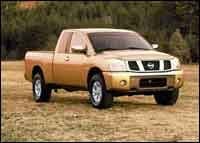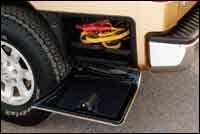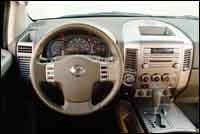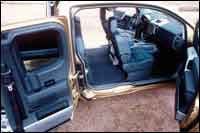Nissan's New Titan: Not a Typical 'Import'
Ever since its Datsun days, Nissan's pickup trucks have been compacts. So have Toyota's, except for the midsize mid-'90s T100 and the current 7/8-full-size Tundra. Thus, most people associate "import" pickups with "small," and when focus-group members were told that Nissan would build a big pickup, they simply would not believe it, even when shown a full-scale mockup of the new Titan.
That's one of the many pieces of information that Nissan executives said they got while extensively researching what buyers of full-size pickups want. Another fact is that there are "traditional" people who are loyal to the trucks they've always bought, and "modern truck guys" willing to try something new.
For the modernists, the company has its brand-new Titan, and the non-believers had better get used to the idea that it really is a big pickup. It's longer, wider and higher than most ½-ton models from Ford, General Motors and Dodge. It has some features they don't, hauls as much or more, and handles as well or better. And its V8 engine is about as burly as you'll find in any pickup.
My driving impressions are based on jaunts in several King Cab and Crew Cab Titans, all during a late-summer press intro in California's Napa Valley. I also drove and rode in a couple of the Pathfinder Armada sport-utility vehicles, which went on sale in September. Armadas are based on the Titan, but have an independent rear suspension and, of course, the much-enlarged cabin and seating that are typical of full-size SUVs.
For this story, I'll concentrate on the Titan King Cab, because that's what most Titans bought to do some work are likely to be. Cab-and-a-half models like GM's Extended and Ford's Super now constitute almost half the pickup market, and crew-cab models comprise another third, Nissan's research shows. Sales of regular-cab pickups, which fleets are most likely to buy, are declining, and now constitute only a fifth of the market; profits on them are less, so Nissan is staying away from that segment.
You can form your own opinion on the Titan's exterior styling, but I found it handsome if not entirely original. Its brutish nose bears a family resemblance to the compact Frontier, while from other angles it looks something like the latest Dodge Ram. A bystander on one of the driving courses asked if it was a Dodge, so my eyes are not alone on that score.
Interior styling—especially of the instrument panel and dashboard—is close to that in the 2004 Ford F150. For instance, the dash has a distinctive center section with controls for the heater/air conditioner and the radio/sound system. And the analog gauges resemble Ford's, unfortunately including no numbers on engine condition readouts.
Nissan's gauges are that way because most people don't know how to use numbers, and get alarmed if a needle climbs or drops to digits that are still normal for the engine, a marketing executive explained. Nissan's needles stay close to center during normal fluctuations, but will still warn of unusual conditions, with backup from "idiot" lights.
The engine is the "Endurance" V8, a modern, electronically controlled unit with aluminum block and heads, double overhead cams and four valves per cylinder. It displaces 5.6 liters (342 cubic inches) and makes 305 horsepower and 379 pounds-feet of torque. That's not the strongest in this class, but it sure feels like it. When you put your foot on the accelerator, this truck really goes, and sounds nice doing it.
The engine's mechanically quiet, but its exhaust note is deep and mellow—something engineered in because most pickup owners said they want to hear it. The aimed-for sound is between that of the latest Dodge Magnum Hemi 5700 and a GM 6000 V8 with a Flowmaster muffler, one Nissan engineer said.
An electronically controlled five-speed automatic transmission—no manual is available—provides the right ratios for any situation, and always shifts very smoothly. There's a tow-haul switch that raises shift-point revs and helps with downshifting on downgrades. Titan's optional trailer-towing package includes a temperature gauge for the transmission, giving you something to look at during long but otherwise boring uphill pulls.
The tranny's 5th gear is a 0.834 overdrive which, combined with a "fast" 2.937 axle ratio that's standard in two-wheel-drive models, makes for leisurely revving at cruising speeds and good economy: EPA's estimate for the 2WD Titan is 14 mpg city and 19 mpg highway. A 3.357 ratio comes with the tow package and 4×4s.
The Titan rides well and corners flat. It's got rear leaf springs like all pickups, but even while empty there's little or none of the jouncing that's common on competitors (though less so with their most recent models). And there's no lean as you toss a Titan into turns, thanks to its front wishbone suspension with stabilizer bar. Though it's a big pickup, to me it feels and maneuvers like it's smaller.
Four-wheel-drive Titans have a slightly more firm ride, but it's not harsh. A rotary switch on the dash lets you choose among 2-Hi, 4-Hi and 4-Lo, but there's no neutral. Shorter-legged folks can climb into a Titan 4×4 without needing outside steps because while its suspension is a tad higher, it's not jacked up as on one or two competitors.
Frames include box-section rails shaped throughout their length to achieve desired strength at given points. Frames and suspensions could be beefed up to achieve ¾-ton ratings, and the Titan might have the heavier models some day, executives said.
Three trim levels—XE, SE and LE—determine exterior adornments and interior upholstery. Split bench or captain's seats are available; every one I perched on was comfortable and supportive.
Back-seat passengers in the King Cab have adequate legroom and the Crew Cab offers lots more. Rear seats fold down for cargo stowage; on the SE and LE, the back of the front passenger's seat folds flat for even more room. Overhead consoles are optional on the XE and standard on the others.
Driver and passenger frontal air bags are standard, and side and "curtain" air bags are optional on SE and LE (and maybe later on the XE). The roof should hold up well in a roll-over, though there are no official tests to measure this, at least in the United States.
The King Cab's "wide-open" rear doors swing out 168 degrees, thus folding almost flat against the bed. This allows easy loading of materials without closing the front door, which is especially useful in a parking lot so you can roll a shopping cart up next to the open cab.
You buy a pickup for its bed, of course, and you'll find some neat features in the Titan's. A factory sprayed-in liner is optional—a first from any factory, Nissan claims—as is a "Utili-track" system with five open-section channels to mount tool boxes and tie down cargo. And there's a 12-volt plug toward the rear to power lights and other accessories.
In the outside left corner, behind the rear wheel, is a "bedside" locking compartment in which to stow a hitch shank, jumper cables, and other stuff that you want to keep with the truck but that's too dirty for the cab or too prone to rolling around in it.
The Titan can do some respectable hauling. Specifications say payload is 1,640 pounds (including passengers), and it'll tow up to 9,600 pounds, or 9,400 for a 4×4.
Ford's '04 F150 is the product that Nissan planners seem most concerned with. They referred to it several times during presentations and demonstrations, and they're pricing their Titan against it. But whereas Ford thinks in the millions, Nissan's goal for the Titan's first year is a modest 100,000.
Titan was designed almost entirely in southern California, and just entered full production in a huge new factory at Canton, in central Mississippi. This is a heretofore depressed area, and Nissan people told stories of being treated royally by residents who are genuinely grateful for the thousands of good-paying jobs the plant is bringing.
That's why I put the word import in quotes in this story's lead and Toyota builds its pickups in America, too. You might want to keep it in mind if you're one of those modern truck guys who'll check out the Titan when it hits showrooms before Christmas.






